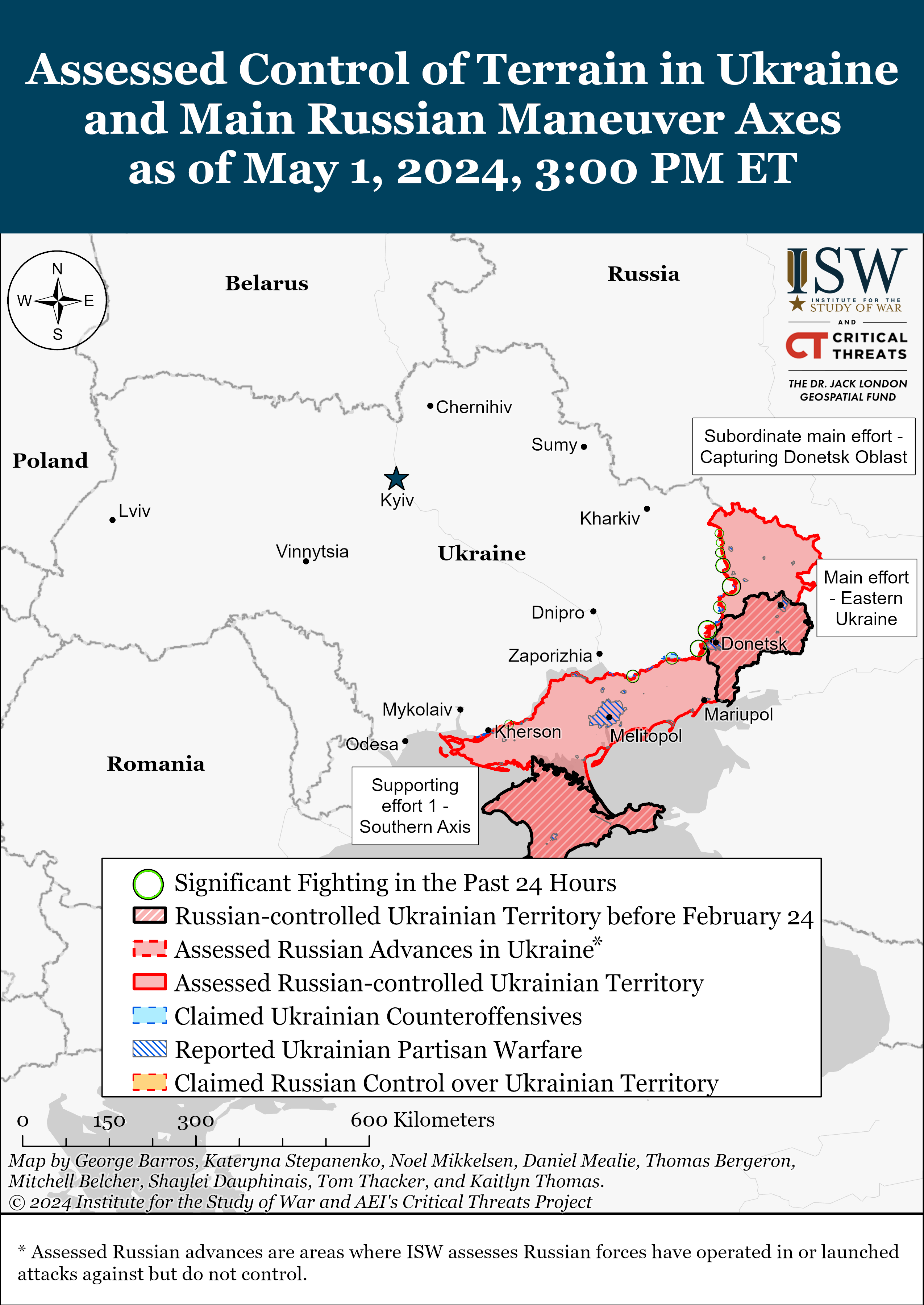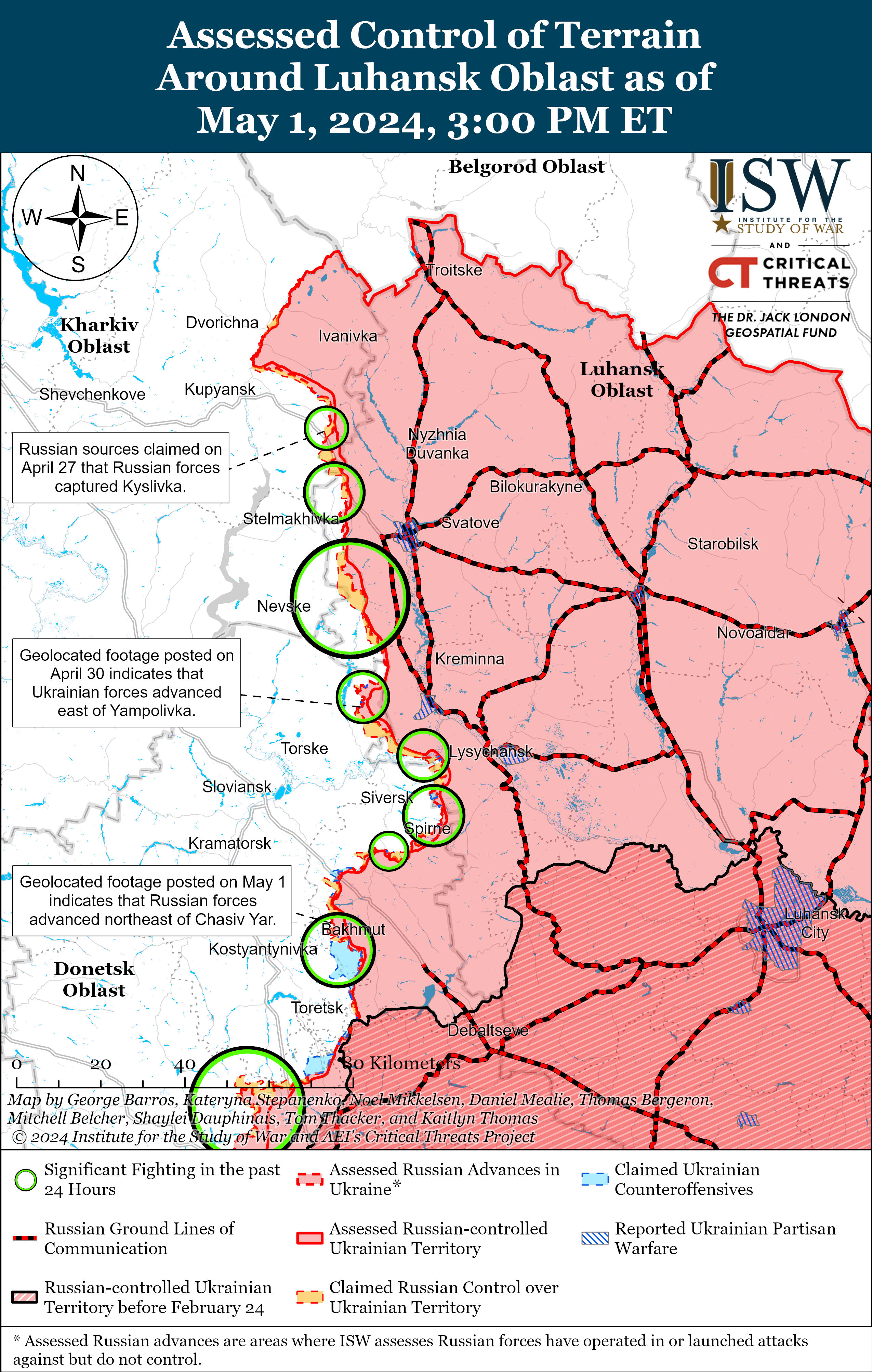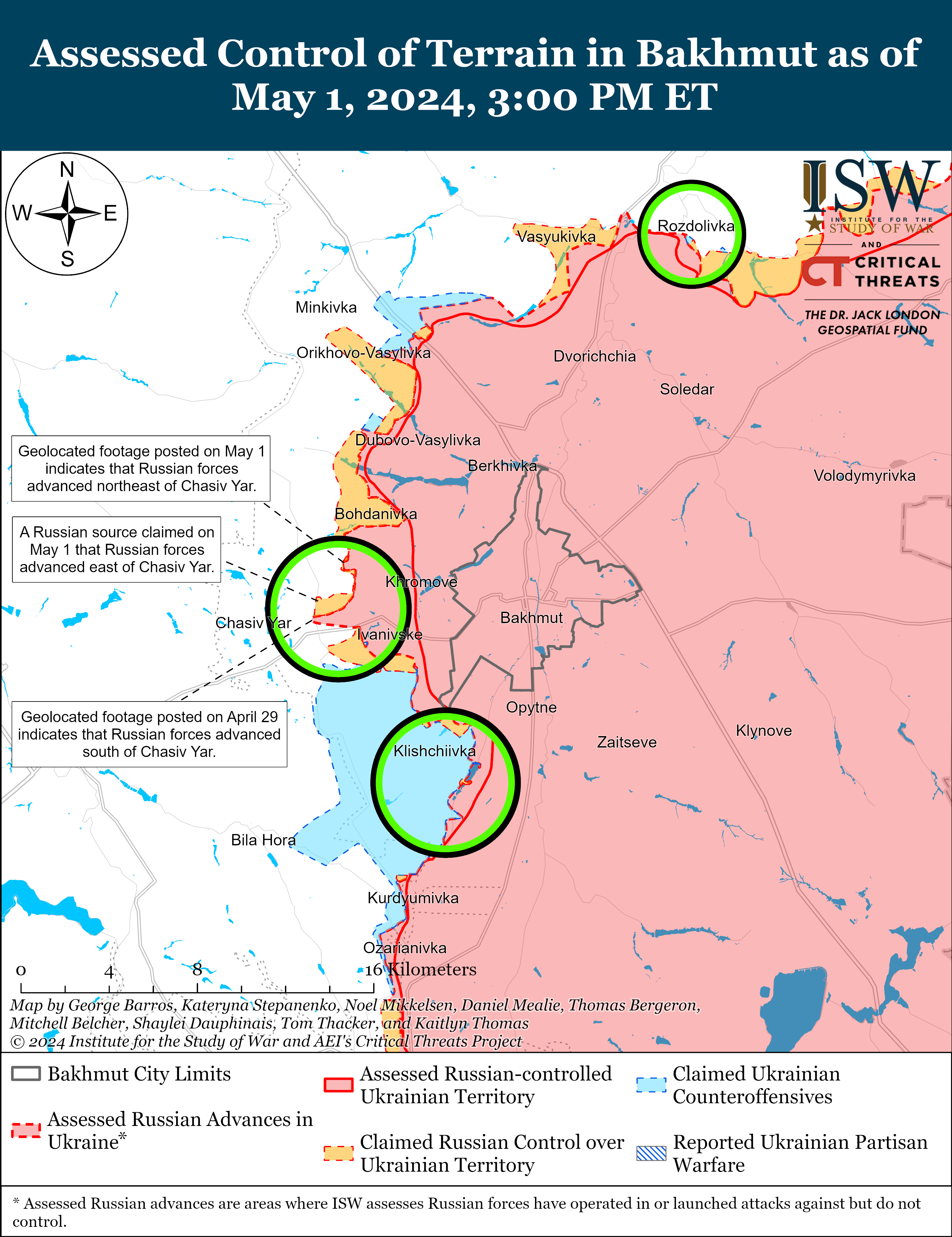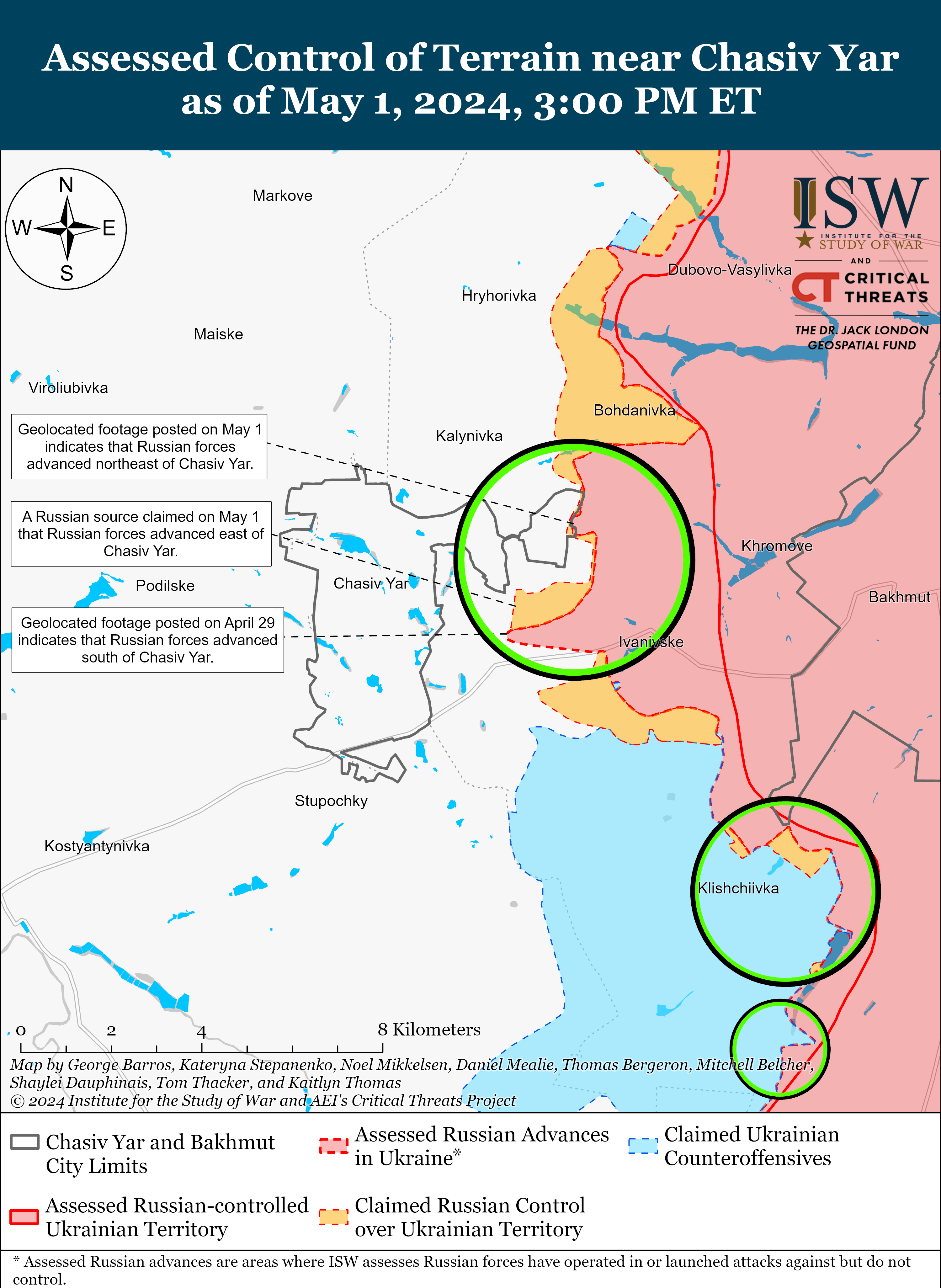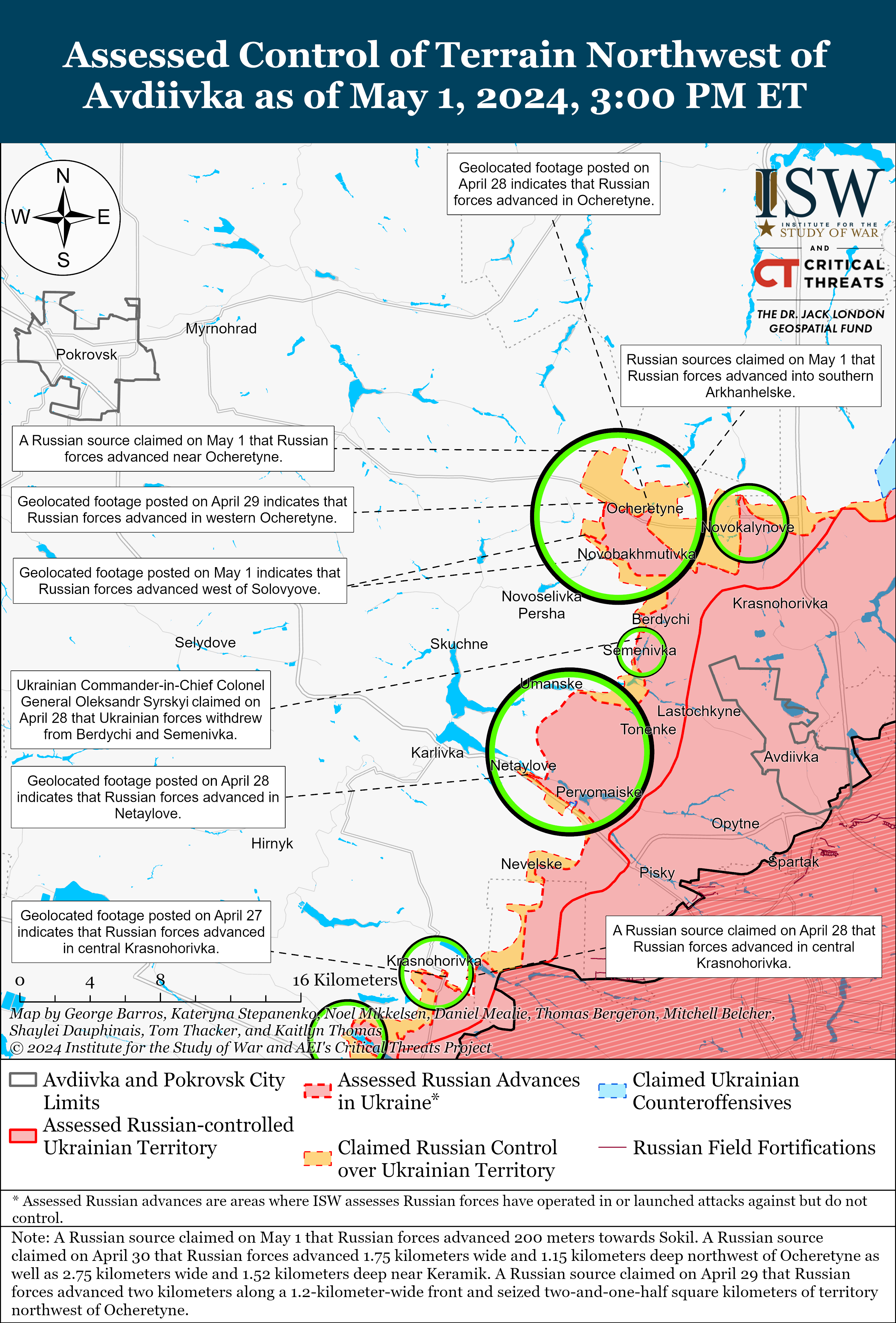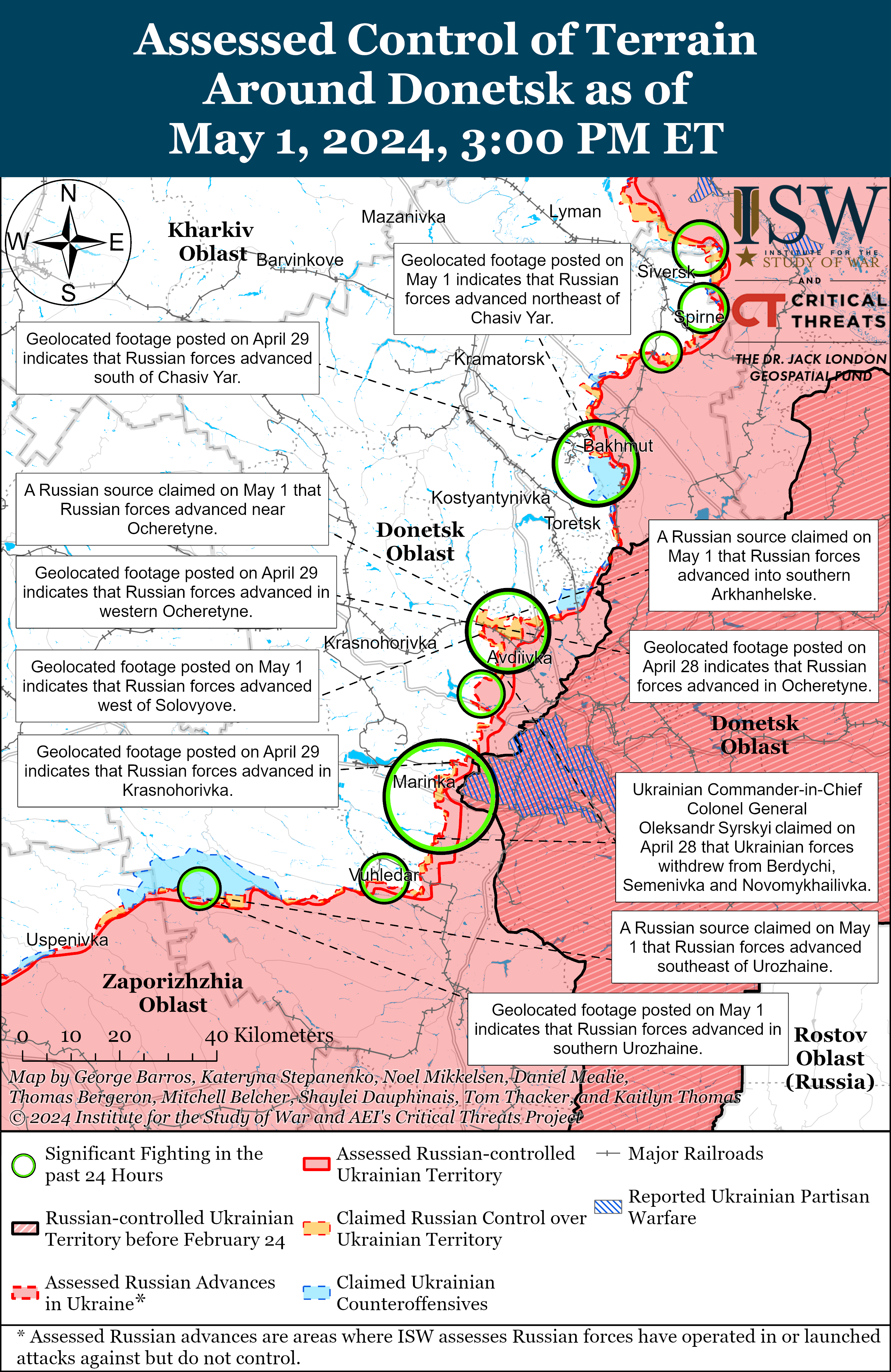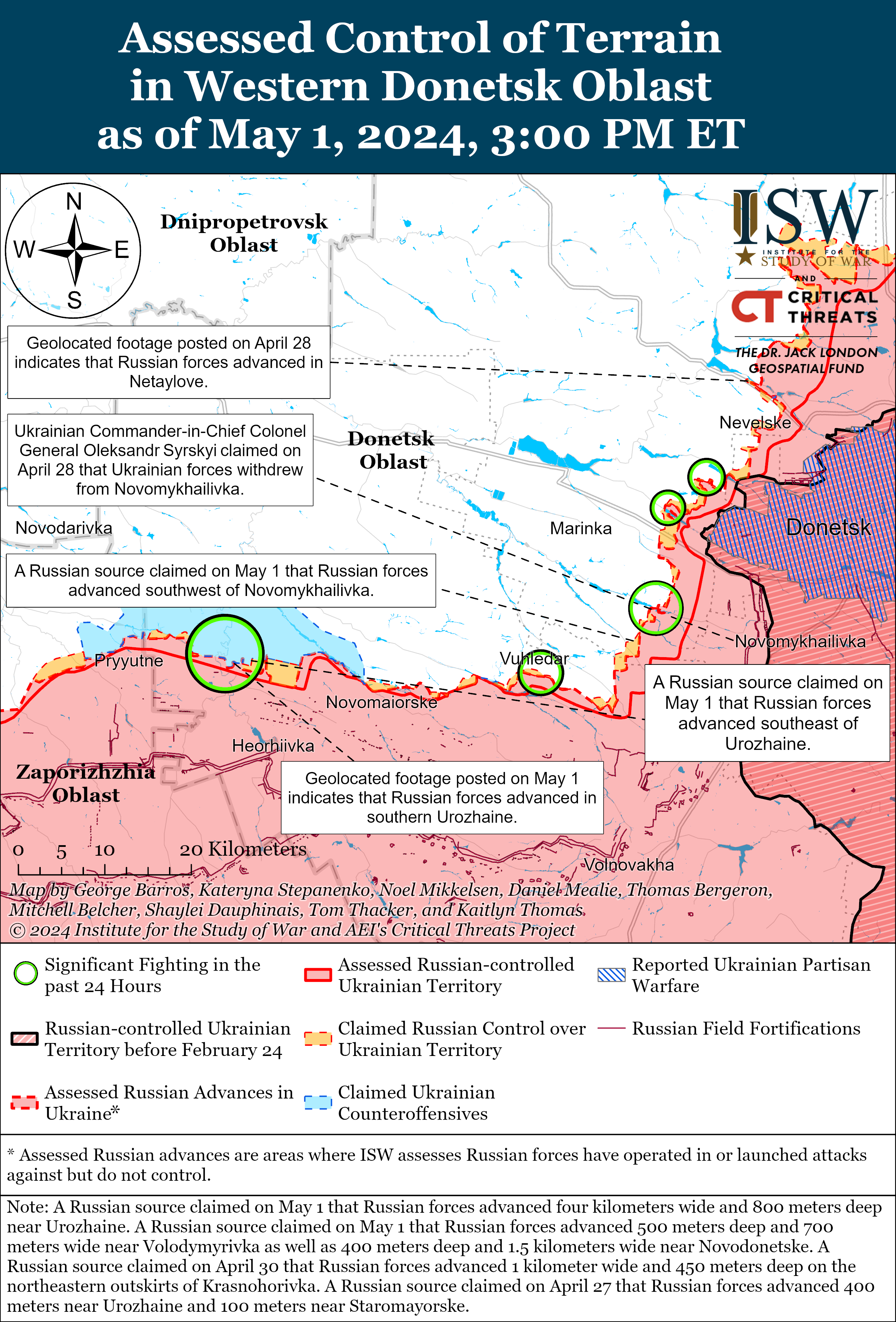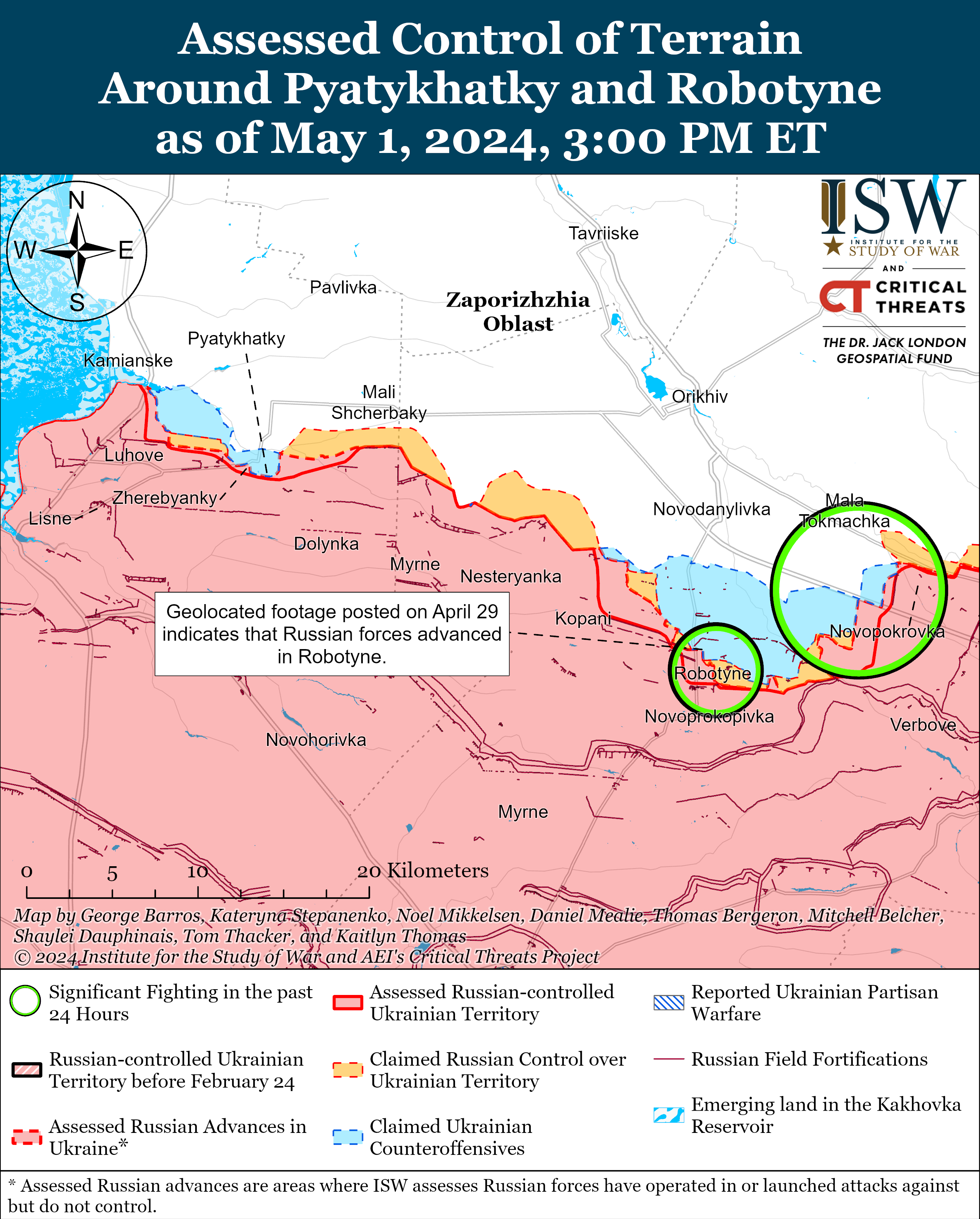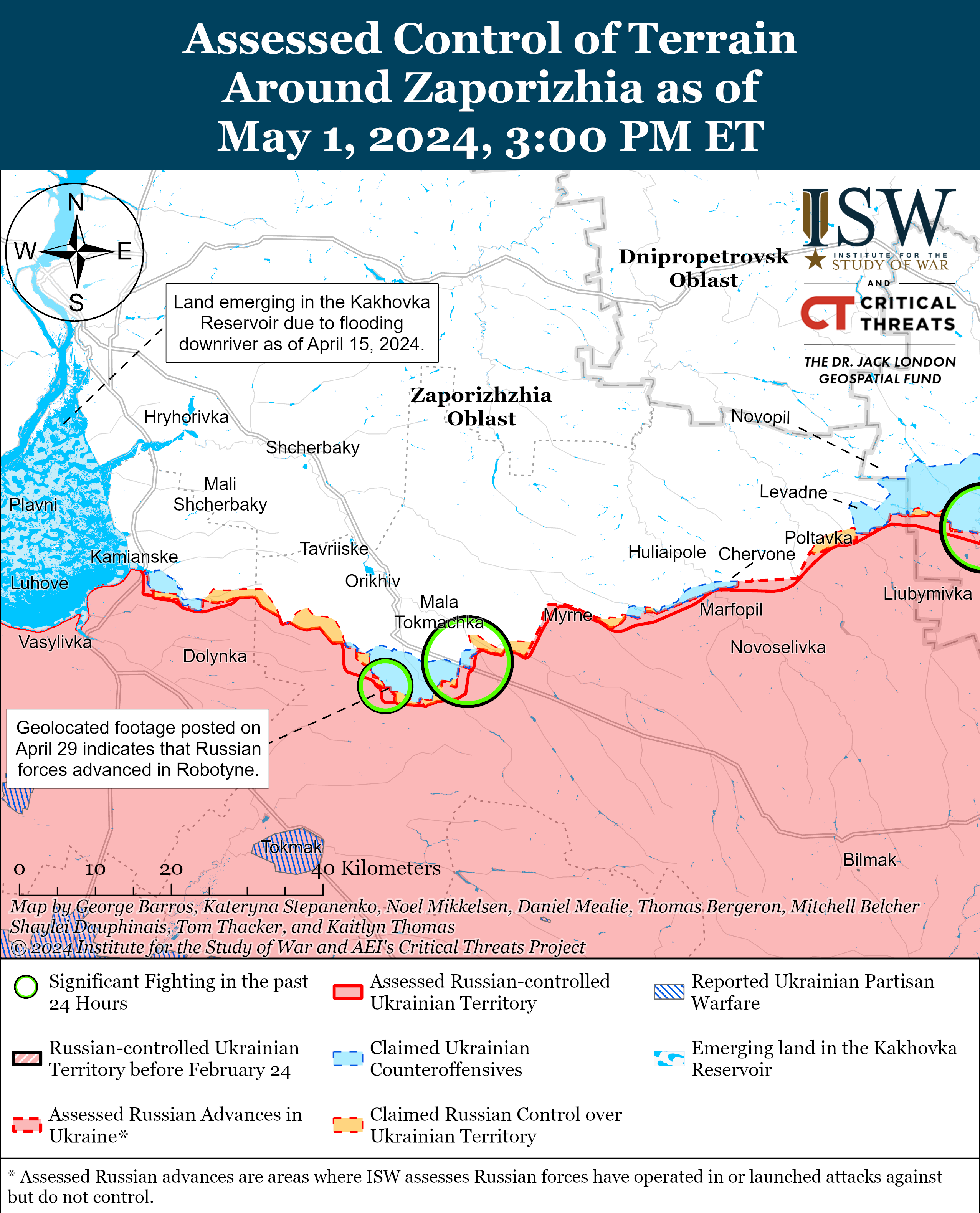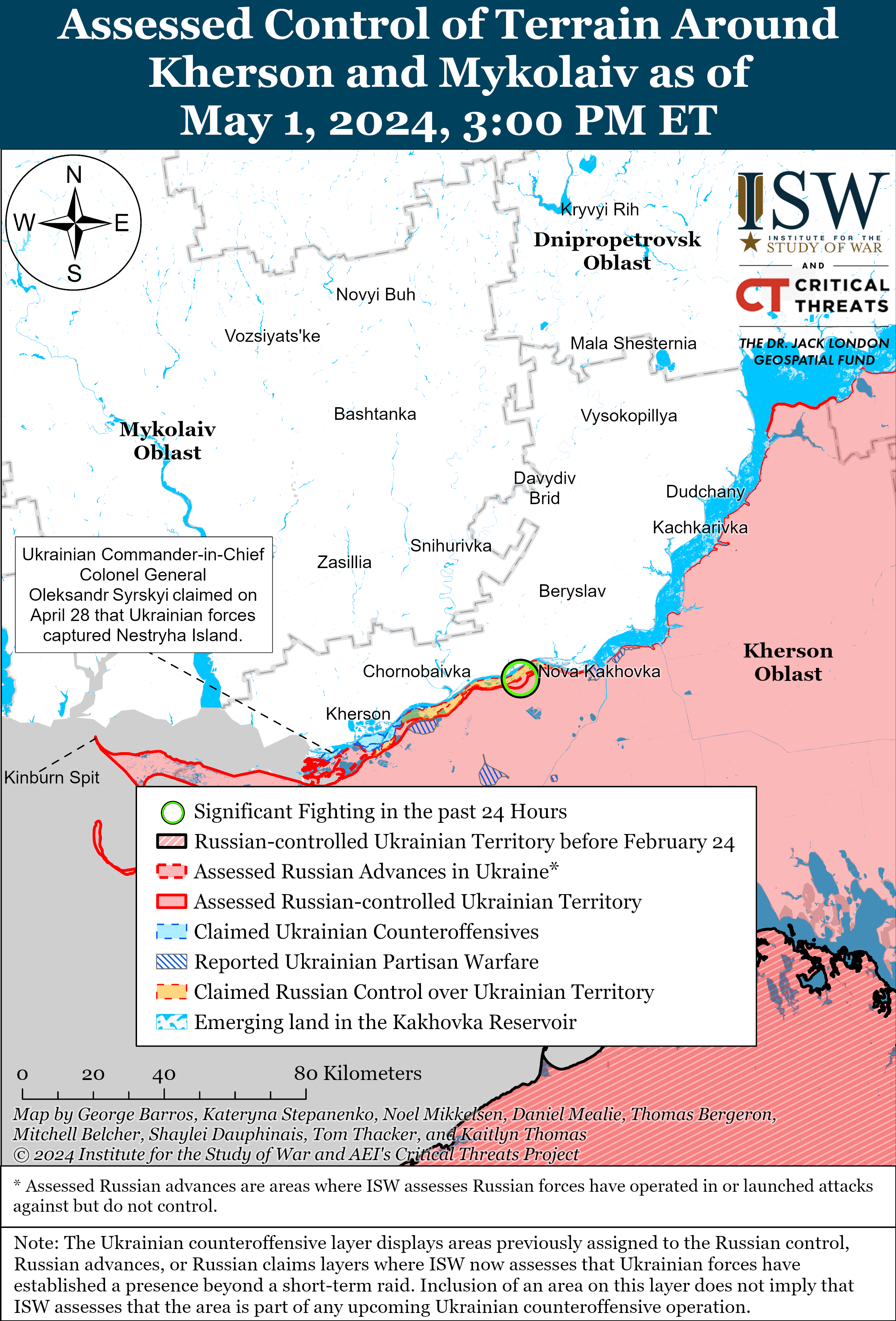RUSSIAN OFFENSIVE CAMPAIGN ASSESSMENT, MAY 1, 2024

Russian Offensive Campaign Assessment, May 1, 2024
Riley Bailey, Christina Harward, Nicole Wolkov, Grace Mappes, and George Barros
May 1, 2024, 7:15pm ET
Click here to see ISW’s interactive map of the Russian invasion of Ukraine. This map is updated daily alongside the static maps present in this report.
Click here to see ISW’s 3D control of terrain topographic map of Ukraine. Use of a computer (not a mobile device) is strongly recommended for using this data-heavy tool.
Click here to access ISW’s archive of interactive time-lapse maps of the Russian invasion of Ukraine. These maps complement the static control-of-terrain map that ISW produces daily by showing a dynamic frontline. ISW will update this time-lapse map archive monthly.
Note: The data cut-off for this product was 12:15pm ET on May 1. ISW will cover subsequent reports in the May 2 Russian Offensive Campaign Assessment.
The Russian military is reportedly redeploying elements of the 76th and 7th airborne (VDV) divisions from Zaporizhia Oblast in the direction of eastern Ukraine, likely to reinforce and intensify ongoing offensive operations. Select Russian and Ukrainian sources claimed that elements of the Russian 76th and 7th airborne (VDV) divisions that have been deployed to the Robotyne area in western Zaporizhia Oblast since the height of the Ukrainian summer 2023 counteroffensive are redeploying to new directions, but disagreed on the units redeploying and the areas to which these elements are redeploying.[1] Ukrainian military observer Kostyantyn Mashovets stated on May 1 that the Russian military command recently decided to redeploy at least a battalion of the 76th VDV Division from the Orikhiv direction (western Zaporizhia Oblast) to the general Luhansk Oblast frontline or the Kramatorsk direction (the Bakhmut direction).[2] A Russian milblogger, who has an avowed bias against VDV and “Dnepr” Grouping of Forces Commander Colonel General Mikhail Teplinsky, claimed on April 29 that the Russian military command decided to redeploy elements of the 76th and 7th VDV divisions from the “Dnepr” Grouping of Forces (deployed in east [left] bank Kherson Oblast and western Zaporizhia Oblast) to other unspecified directions.[3] The milblogger later claimed on May 1 that the Russian command decided to transfer elements of the 76th VDV division to relieve elements of the 104th VDV Division near the limited Ukrainian tactical bridgehead in Krynky, Kherson Oblast.[4] The milblogger has not yet offered any updates on the claimed redeployment of elements of the 7th VDV division. ISW has not yet observed confirmation that elements of the 76th and 7th VDV divisions have redeployed to other directions, though these Russian and Ukrainian reports are significant and any VDV redeployments from Zaporizhia Oblast towards eastern Ukraine warrant closer study in the coming days.
Russian forces notably redeployed elements of the 76th and 7th VDV divisions from the Lyman and Kherson directions to the Robotyne area in mid-summer 2023, and this successful redeployment reinforced Russia’s defense at a critical time to prevent Ukrainian forces from breaching the Russian defense in the area.[5] These redeployed elements of the 76th and 7th VDV divisions conducted counterattacks that demonstrated that the 76th and 7th VDV divisions were relatively more combat effective than other Russian forces at the time, and these Russian elements have likely reconstituted to some degree during low-intensity Russian offensive operations in the Robotyne area since fall 2023. Russian forces have seized most of Robotyne in recent weeks, and the Russian military command may have decided that the likely combat effective elements of the 76th and 7th VDV divisions would be more useful elsewhere.[6]
The Russian military may seek to redeploy elements of the 76th or 7th VDV division or both to eastern Ukraine to support Russia’s offensive operations in Donetsk Oblast and to capitalize on the current window of vulnerability before American military aid begins reaching the frontline at scale. Russian forces are currently attempting to exploit a tactical penetration northwest of Avdiivka to achieve a wider breach in the area and are intensifying offensive operations to seize the operationally significant town of Chasiv Yar.[7] The Russian military command may intend to introduce elements of the 76th and 7th VDV divisions as significant reinforcements to either of these efforts in pursuit of operationally significant gains before the arrival of US security assistance allows Ukrainian forces to slow Russian advances and stabilize the frontline.[8] Russian forces in the Avdiivka direction have currently established a relatively cohesive grouping of forces comprised mainly of elements of the Central Military District (CMD) and the Donetsk People’s Republic (DNR) 1st Army Corps (AC), though these forces are likely attritted from conducting intense offensive operations over the past several months, and elements of the 76th and 7th VDV could serve as an exploitation force to press on with attacks in the area.[9] Russian forces have established a less cohesive grouping of forces in the Bakhmut direction that is notably comprised of elements of several VDV divisions and brigades, and redeployments of elements of the 76th and 7th to this area could reinforce the ongoing offensive operation to seize Chasiv Yar.[10] The Russian military command could deploy elements of the 76th and 7th VDV divisions to the Kupyansk-Svatove-Kreminna line where Russian forces have resumed offensive operations along the entire line, but Russian forces appear to be attempting to consolidate this entire sector under the responsibility of the Moscow Military District (MMD), and redeployments of the 76th and 7th VDV divisions may not be as useful in this effort relative to more intensive operations currently underway in Donetsk Oblast.[11] Any redeployment of these elements would offer Russian forces the opportunity to intensify offensive operations and place Ukrainian forces under increasing pressure regardless of the location. ISW offers no assessment of which area is the most likely area where VDV forces may redeploy, if they redeploy at all. ISW will continue to monitor reports about the possible redeployment of elements of the 76th and 7th VDV divisions as it poses a significant risk to Ukraine’s ability to slow ongoing Russian offensive operations in eastern Ukraine in the coming weeks ahead of the arrival of US security assistance.
Ukrainian forces struck an oil refinery in Ryazan Oblast for the second time in less than a month on the night of April 30 to May 1. Ukrainian outlets Suspilne and RBK-Ukraine reported that sources in Ukraine’s Main Military Intelligence Directorate (GUR) stated that the GUR conducted a drone strike on the Rosneft oil refinery in Ryazan City.[12] Ukrainian and Russian sources posted footage of a fire at the refinery.[13] The Russian Ministry of Defense (MoD) claimed that Russian forces shot down one drone over Ryazan Oblast.[14] Ryazan Oblast governor Pavel Malkov acknowledged that a drone struck Ryazan Oblast, however, but did not specify any damage.[15] Ukrainian forces first struck the Ryazan oil refinery on the night of March 12 to 13.[16] Ukrainian strikes within Russia are reportedly forcing Russian forces to take additional defensive measures.[17] Ukrainian military observer Kostyantyn Mashovets stated that Russian forces have begun to withdraw up to 43 operational-tactical and army aircraft from forward air bases, likely out of fear of Ukrainian drone and long-range high-precision strikes.[18] Mashovets stated that the total number of Russian aircraft deployed at frontline air bases has decreased from 303–305 aircraft to 280–283 aircraft.
Russian state-run news outlets appear to be amplifying anti-Western rhetoric from former Georgian Prime Minister and founder of the Georgian Dream party Bidzina Ivanishvili and are negatively portraying Georgians protesting against Georgia’s “foreign agents” bill, likely in an attempt to destabilize and divide Georgia. Radio Free Europe/Radio Liberty’s (RFE/RL) Georgian service Radio Tavisupleba reported on May 1 that Russian state-run news outlets Rossiya-1, NTV, and Channel One (Perviy Kanal) are amplifying anti-Western rhetoric from Ivanishvili’s April 29 speech.[19] ISW previously reported that Ivanishvili reiterated a series of standard anti-Western and pseudohistorical Kremlin narratives during his first public speech since announcing his return to Georgian public politics in December 2023.[20] Radio Tavisupleba reported that Russian state media framed the protestors as “aggressive” and “radicals” who attacked Georgian law enforcement while celebrating Ivanishvili‘s criticisms of the West.[21] Kremlin newswire TASS similarly seized on allegations of violence and “mass arrests” and claimed that protestors “provoked” Georgian security forces.[22] Russian state media’s focus on Ivanishvili’s statements and their negative portrayal of protestors is likely part of ongoing efforts to destabilize, divide, and weaken domestic Georgian politics. The Kremlin has routinely attempted to portray Ukraine’s and other post-Soviet countries’ politics as chaotic in an attempt to destabilize target states and make them more susceptible to Russian influence or outright attack.[23]
The United Nations (UN) and Western organizations continue to demonstrate how North Korea and the People’s Republic of China (PRC) are directly and indirectly helping Russia’s war effort. Reuters reported on April 29 that the UN North Korean sanctions monitoring panel issued a report to the UN Security Council (UNSC) confirming that Russian forces used a North Korean Hwasong-11 ballistic missile in a strike on Kharkiv City on January 2, 2024.[24] The panel reportedly noted that Russia’s use of North Korean missiles violated the 2006 UN arms embargo on North Korea. Russia vetoed an annual UNSC resolution extending the monitoring panel on March 28, and the panel’s mandate expired on April 30.[25] The Economist reported on April 29 that the PRC is providing Russia with semiconductors, navigation equipment, jet parts, ball bearings, computer numerical controlled tools, and other dual-use equipment supporting Russian arms production.[26] The Economist, citing data from the Center for Strategic International Studies (CSIS), reported that Russia often imports goods through a complex system of shell companies, many of which can be traced back to the PRC. The Economist noted that Russian imports of goods from the PRC appeared to surge following Russian President Vladimir Putin’s meeting with PRC President Xi Jinping in Moscow in March 2023. US Secretary of State Antony Blinken stated on May 1 that Russian imports of dual-use items from the PRC have helped Russia significantly increase its defense industrial production and that 70 percent of Russia’s machine tools and 90 percent of its microelectronics come from the PRC.[27] ISW previously reported about the recent uptick in public meetings between Russian, PRC, North Korean, Iranian, and Belarussian officials that underscores these countries’ deepening mutual partnership aimed at confronting the West.[28]
Russian insider sources speculated that the criminal investigation into Russian Deputy Defense Minister Timur Ivanov may also implicate another deputy defense minister, Rustam Tsalikov. A Russian insider source claimed on April 26 that the Russian Federal Security Service (FSB) summoned Tsalikov for questioning, and later claimed on April 27 that the Russian Ministry of Defense (MoD) may force Tsalikov into retirement and that authorities may bring criminal charges against Tsalikov in relation to Ivanov’s bribery case, for which Ivanov was arrested on April 24.[29] The insider source claimed that Tsalikov is the third highest-ranking member of the Russian MoD only behind Defense Minister Sergei Shoigu and Chief of the General Staff Army General Valery Gerasimov and that Tsalikov is a close ally of Shoigu like Ivanov. The UK MoD published a corroborating report on May 1 citing unspecified Russian sources.[30] ISW is unable to confirm the Russian claims, however. The Russian MoD has not commented on reports of an investigation involving Tsalikov and notably featured Tsalikov visiting a Russian drone production enterprise on its Telegram channel on April 30.[31]
Bloomberg reported that four sanctioned Russian oil tankers have changed their names and are sailing under new flags.[32] Bloomberg reported on April 30 that tankers from Sovcomflot, Russia’s state-owned oil tanker company, renamed four of its sanctioned vessels: the NS Columbus to the Kemerovo, the NS Bravo to the Belgorod, the NS Captain to the Kaliningrad, and the NS Creation to the Krasnoyarsk. Bloomberg reported that these ships are now flying Russian flags after previously sailing with Gabonese flags. The US Treasury Department sanctioned Sovcomflot and 14 of its vessels in February 2024, and Bloomberg reported that it is common for sanctioned vessels to change their names to distance themselves from international sanctions even though each ship has a permanent identification number that remains the same despite a name change. It is unclear why these ships changed their names and flags to highlight their connection with Russia, and this decision seems counterproductive if these vessels hope to distance themselves from international sanctions against Russia.
Key Takeaways:
- The Russian military is reportedly redeploying elements of the 76th and 7th airborne (VDV) divisions from Zaporizhia Oblast in the direction of eastern Ukraine, likely to reinforce and intensify ongoing offensive operations.
- The Russian military may seek to redeploy elements of the 76th or 7th VDV division or both to eastern Ukraine to support Russia’s offensive operations in Donetsk Oblast and to capitalize on the current window of vulnerability before American military aid begins reaching the frontline at scale.
- Ukrainian forces struck an oil refinery in Ryazan Oblast for the second time in less than a month on the night of April 30 to May 1.
- Russian state-run news outlets appear to be amplifying anti-Western rhetoric from former Georgian Prime Minister and founder of the Georgian Dream party Bidzina Ivanishvili and are negatively portraying Georgians protesting against Georgia’s “foreign agents” bill, likely in an attempt to destabilize and divide Georgia.
- The United Nations (UN) and Western organizations continue to demonstrate how North Korea and the People’s Republic of China (PRC) are directly and indirectly helping Russia’s war effort.
- Russian insider sources speculated that the criminal investigation into Russian Deputy Defense Minister Timur Ivanov may also implicate another deputy defense minister, Rustam Tsalikov.
- Bloomberg reported that four sanctioned Russian oil tankers have changed their names and are sailing under new flags.
- Russian forces made confirmed advances near Chasiv Yar and Avdiivka and in the Donetsk-Zaporizhia Oblast border area.
- Russian authorities continue recruiting convicted criminals to fight in Ukraine.
We do not report in detail on Russian war crimes because these activities are well-covered in Western media and do not directly affect the military operations we are assessing and forecasting. We will continue to evaluate and report on the effects of these criminal activities on the Ukrainian military and the Ukrainian population and specifically on combat in Ukrainian urban areas. We utterly condemn Russian violations of the laws of armed conflict and the Geneva Conventions and crimes against humanity even though we do not describe them in these reports.
- Russian Main Effort – Eastern Ukraine (comprised of two subordinate main efforts)
- Russian Subordinate Main Effort #1 – Capture the remainder of Luhansk Oblast and push westward into eastern Kharkiv Oblast and encircle northern Donetsk Oblast
- Russian Subordinate Main Effort #2 – Capture the entirety of Donetsk Oblast
- Russian Supporting Effort – Southern Axis
- Russian Air, Missile, and Drone Campaign
- Russian Mobilization and Force Generation Efforts
- Russian Technological Adaptations
- Activities in Russian-occupied areas
- Ukrainian Defense Industrial Base Efforts
- Russian Information Operations and Narratives
- Significant Activity in Belarus
Russian Main Effort – Eastern Ukraine
Russian Subordinate Main Effort #1 – Luhansk Oblast (Russian objective: Capture the remainder of Luhansk Oblast and push westward into eastern Kharkiv Oblast and northern Donetsk Oblast)
Ukrainian military observer Kostyantyn Mashovets stated that the Russian Northern Grouping of Forces has deployed no fewer than 50,000 Russian personnel to its area of responsibility in Kursk, Bryansk, and Belgorod oblast border areas.[33] Mashovets stated that the Russian 44th Army Corps (AC) (Leningrad Military District [LMD]) has contributed up to 3,700 Russian personnel to the Northern Grouping of Forces and will deploy elements of the 44th Army Corps to Kursk Oblast, including elements of the likely reformed 128th Motorized Rifle Brigade, 30th Motorized Rifle Regiment (72nd Motorized Rifle Division), and 197th Separate Control Battalion.
Russian forces continued ground attacks along the Kupyansk-Svatove-Kreminna line on May 1. The Ukrainian General Staff reported that Ukrainian forces repelled Russian assaults southeast of Kupyansk near Ivanivka, Kyslivka, and Kotlyarivka; northwest of Svatove near Berestove and Stelmakhivka; west of Svatove near Kopanky; and southwest of Svatove near Novoyehorivka, Hrekivka, Makiivka, and Nevske; west of Kreminna near Terny; and south of Kreminna near Bilohorivka and in the Serebryanske forest area.[34] Elements of the Russian 2nd Artillery Brigade (2nd Luhansk People’s Republic Army Corps [LNR AC]) are reportedly operating near Bilohorivka.[35]
Ukrainian forces recently struck a Russian military training ground about 80 kilometers behind the frontline in the rear of occupied Luhansk Oblast. Geolocated footage published on May 1 indicates that Ukrainian forces struck a Russian training ground southwest of Mozhnyakivka, likely with four ATACMS, and reportedly killed 116 Russian personnel.[36]
Russian Subordinate Main Effort #2 – Donetsk Oblast (Russian objective: Capture the entirety of Donetsk Oblast, the claimed territory of Russia’s proxies in Donbas)
Positional fighting continued in the Siversk direction (northeast of Bakhmut) on May 1, but there were no confirmed changes to the frontline. Fighting continued east of Siversk near Verkhnokamyanske, southeast of Siversk near Spirne, and south of Siversk near Rozdolivka.[37] Elements of the Russian “GORB” detachment (2nd Luhansk People‘s Republic [LNR] Army Corps [AC]) are reportedly operating near Spirne.[38]
Russian forces recently advanced east of Chasiv Yar and on Chasiv Yar’s eastern outskirts. Geolocated footage published on May 1 indicates that Russian forces recently advanced through forest areas immediately east of Chasiv Yar and further along the outskirts of the Kanal Microraion (easternmost Chasiv Yar).[39] Russian milbloggers claimed that elements of the Russian 200th Motorized Rifle Brigade (14th AC, Leningrad Military District [LMD]) advanced near Bohdanivka (northeast of Chasiv Yar) and that elements of the 98th Airborne (VDV) Division and 11th VDV Brigade reached the eastern edge of a section of the Siverskyi-Donets Donbas Canal south of Chasiv Yar.[40] Russian milbloggers claimed that there are reports that Ukrainian forces have begun to withdraw from Klishchiivka (southeast of Chasiv Yar), although one milblogger acknowledged that he had yet to confirm the reports with his own sources.[41] ISW has not observed confirmation of any of these Russian claims. Fighting continued northeast of Chasiv Yar near Bohdanivka; near the Kanal and Novyi microraions in eastern Chasiv Yar; southeast of Chasiv Yar near Klishchiivka and Andriivka; and south of Chasiv Yar near Shumy and Niu York.[42] Elements of the Russian 10th Spetsnaz Brigade (Main Military Intelligence Directorate [GRU]) are reportedly operating near Chasiv Yar.[43]
Russian forces recently advanced further northwest of Avdiivka and reportedly made additional gains on May 1. Geolocated footage published on May 1 indicates that Russian forces advanced southwest and west of Solovyove (northwest of Avdiivka), and Russian milbloggers claimed that Russian forces, including elements of the 55th Motorized Rifle Brigade (41st Combined Arms Army [CAA], Central Military District [CMD]), advanced further in the area towards Sokil (west of Solovyove and northwest of Avdiivka).[44] Russian milbloggers claimed that Russian forces recently broke through Ukrainian defenses northeast of Ocheretyne (northwest of Avdiivka) and have been operating within southern Arkhanhelske (northeast of Ocheretyne and north of Avdiivka) for the past two days.[45] Russian milbloggers claimed that Russian forces advanced in fields southwest and northwest of Ocheretyne, west of Novokalynove (north of Avdiivka), northwest of Keramik (north of Avdiivka), and east of Novooleksandrivka (northwest of Avdiivka and Ocheretyne).[46] Fighting also continued north of Avdiivka near Kalynove; northwest of Avdiivka near Prohres, Novopokrovske, and Berdychi; west of Avdiivka near Semenivka, Umanske, and Yasnobrodivka; and southwest of Avdiivka near Netaylove.[47] Elements of the Russian 9th Motorized Rifle Brigade (1st Donetsk People’s Republic [DNR] AC) are reportedly operating near Netaylove.[48]
Russian forces reportedly seized Paraskoviivka (southwest of Donetsk City) on May 1, although there were no confirmed Russian gains west or southwest of Donetsk City. Russian milbloggers claimed that Russian forces seized Paraskoviivka, although ISW has not observed visual confirmation of Russian forces operating within the settlement.[49] Russian milbloggers claimed that Russian forces also advanced in fields southwest of Novomykhailivka (southwest of Donetsk City) and north of Volodymyrivka (southwest of Donetsk City).[50] Fighting continued west of Donetsk City near Krasnohorivka and Heorhiivka and southwest of Donetsk City near Novomykhailivka, Paraskoviivka, and Vodyane.[51] Elements of the Russian 103rd Motorized Rifle Regiment (150th Motorized Rifle Division, 8th CAA, Southern Military District [SMD]) are reportedly operating near Heorhiivka, and elements of the 238th Artillery Brigade (8th CAA, SMD) are reportedly operating near Krasnohorivka.[52]
Russian forces recently made a confirmed advance in the Donetsk-Zaporizhia Oblast border area amid continued fighting in the area on May 1. Geolocated footage published on May 1 indicates that Russian forces advanced in southern Urozhaine (south of Velyka Novosilka).[53] Russian milbloggers claimed that Russian forces advanced near Urozhaine (south of Velyka Novosilka) along a front almost four kilometers wide and 800 meters deep and that Russian forces control southern Urozhaine.[54] A Russian source also claimed that Russian forces advanced up to 1.5 kilometers wide and 400 meters deep near Novodonetske (southeast of Velyka Novosilka), but ISW has not observed visual confirmation of this claim.[55] Fighting also continued near Staromayorske (south of Velyka Novosilka).[56] Elements of the Russian 11th Air Force and Air Defense Army (Russian Aerospace Forces and Eastern Military District [EMD]) are reportedly operating near Staromayorske, and elements of the 36th Motorized Rifle Brigade (29th CAA, EMD) are reportedly operating near Vuhledar.[57]
Russian Supporting Effort – Southern Axis (Russian objective: Maintain frontline positions and secure rear areas against Ukrainian strikes)
Positional engagements continued in western Zaporizhia Oblast on May 1, but there were no confirmed changes to the frontline in this area. Some Russian milbloggers claimed that Russian forces completely seized Robotyne after raising a Russian flag in the settlement, but other Russian sources claimed that Ukrainian forces retain positions in the settlement, that the footage of the Russian flag is not new, and that Russian forces withdrew from their positions in Robotyne after filming the footage.[58] A Russian milblogger claimed that eastern Robotyne is a contested “gray zone.”[59] Positional engagements continued near Robotyne, Bilohirya (northeast of Robotyne), and Mala Tokmachka (northeast of Robotyne).[60] Elements of the Russian 42nd Motorized Rifle Division (58th Combined Arms Army [CAA], Southern Military District [SMD]) are reportedly operating in the Zaporizhia direction, and elements of the 108th Airborne (VDV) Regiment (7th VDV Division) are reportedly operating west of Verbove.[61]
Positional engagements continued in east (left) bank Kherson Oblast near Krynky.[62] Elements of the Russian 810th Naval Infantry Brigade (Black Sea Fleet) are reportedly operating near Krynky.[63]
Russian Air, Missile, and Drone Campaign (Russian Objective: Target Ukrainian military and civilian infrastructure in the rear and on the frontline)
Russian forces conducted a limited missile strike targeting Odesa Oblast on the night of April 30 to May 1. Ukrainian officials reported that Russian forces struck Odesa City with three Iskander-M ballistic missiles and destroyed civilian infrastructure.[64] Geolocated footage published on May 1 indicates that Russian forces struck the peacetime headquarters of Ukraine’s Southern Operational Command in Odesa City, and multiple Russian sources, including the Russian Ministry of Defense (MoD) claimed that Russian forces struck the headquarters.[65] It is unclear if Ukraine’s Southern Operational Command was currently operating out of the peacetime headquarters. Ukrainian Air Force Spokesperson Major Ilya Yevlash stated that Ukraine needs more Patriot air defense systems, which Ukrainian forces have previously successfully used to shoot down ballistic missiles including the Iskanders.[66]
Ukraine’s Main Military Intelligence Directorate (GUR) reported that Russian forces have about 40 Zircon hypersonic missiles, 400 Onyx anti-ship missiles, 270 Kalibr cruise missiles, and 45 Kh-69 cruise missiles stockpiled as of the end of April 2024.[67] The GUR reported that Russia can produce 10 Zircon missiles, 10 Onyx missiles, 30 to 40 Kalibr missiles, and one to three Kh-69 missiles per month.
Russian Mobilization and Force Generation Efforts (Russian objective: Expand combat power without conducting general mobilization)
Russian authorities continue recruiting convicted criminals to fight in Ukraine. Russian media reported on April 30 that Trans-Baikal Krai Head Alexander Osipov approved the release of Dmitry Vedernikov, head of the “Metsenatovskie” Trans-Baikal organized criminal group, from prison to fight with the Russian military in Ukraine.[68] Vedernikov was serving a 24-year sentence in a maximum-security penal colony, and Russian sources reported that Vedernikov left the penal colony for Ukraine sometime in 2024. The sources reported that Vedernikov first appealed in October 2023 to go to the front but that Russian authorities refused the request. Vedernikov claimed that two other members of the “Metsenatovskie” criminal group have left prison to fight in Ukraine.[69]
Russian authorities continue international military recruitment efforts to staff its units in Ukraine. The Ukrainian Main Military Intelligence Directorate (GUR) published a list on May 1 of many Nepalese citizens serving in the Russian 1099th Motorized Rifle Regiment.[70] The GUR reported that this regiment is currently serving in Luhansk Oblast and that many of these soldiers have deserted after the unit suffered extreme losses during infantry-led “meat” assaults, brutality from Russian field commanders, and extrajudicial executions for refusing to comply with orders.
Russian Technological Adaptations (Russian objective: Introduce technological innovations to optimize systems for use in Ukraine)
The Kremlin continues to celebrate the role of the Russian defense industrial base (DIB) in sustaining Russia’s war effort. Russian President Vladimir Putin awarded multiple Russians with the “Hero in Labor” award and five DIB enterprises with the “Success in Labor” award, including Sevmash (shipbuilding enterprise) General Director Mikhail Budnichenko and “Raduga” State Engineering Bureau (missile and related technologies company) Chief Designer Eltugan Syzdykov.[71] Russian Defense Minister Sergei Shoigu stated during a meeting at the Russian Joint Group of Forces Headquarters on May 1 that the Russian DIB needs to further increase its production to meet the needs of the Russian military.[72]
A Russian milblogger who has previously fought in occupied Ukraine claimed on May 1 that the increased prevalence of Russian “turtle” tanks – tanks jerry-rigged with metal plating covering most sides – on the battlefield indicates that the Russian DIB has failed to develop full-fledged defenses for Russian armor against drone strikes.[73] The milblogger claimed that the Lesochka and Volnoreza electronic warfare (EW) systems that Russian forces currently receive are not effective against Ukrainian drones, but that the more effective Troika and Ogonyok systems are too expensive for the Russian Ministry of Defense (MoD) to distribute among Russian forces at scale.[74]
Ukrainian Defense Industrial Efforts (Ukrainian objective: Develop its defense industrial base to become more self-sufficient in cooperation with US, European, and international partners)
ISW is not publishing coverage of Ukrainian defense industrial efforts today.
Activities in Russian-occupied areas (Russian objective: Consolidate administrative control of annexed areas; forcibly integrate Ukrainian citizens into Russian sociocultural, economic, military, and governance systems)
ISW is not publishing coverage of Russian-occupied areas of Ukraine today.
Russian Information Operations and Narratives
The Russian Ministry of Defense (MoD) continues to hyper-fixate on Russia’s ability to destroy Western-made weapons, likely to posture Russian military equipment as superior to Western designs and bolster domestic support for the war. The Russian MoD formally opened a display of about 30 captured Western-made Ukrainian military vehicles in Victory Park in Moscow on May 1 and encouraged Russian citizens to visit the exhibition.[75] Russia has previously given military and monetary awards to Russian soldiers who destroyed Western armored vehicles.[76]
A prominent Kremlin-affiliated Russian milblogger continued to frame ongoing Baltic and joint Central European-Ukrainian logistics projects against the backdrop of ongoing NATO Steadfast Defender 2024 exercises as escalatory against Russia. The milblogger baselessly claimed that such transportation projects are evidence that NATO is preparing for a conflict with Russia.[77] Russian officials and Kremlin mouthpieces have routinely and deliberately misrepresented NATO Steadfast Defender 2024 exercises as a threat against Russia despite the exercises’ defensive response to real Russian aggression against Ukraine and overt Russian threats against NATO states.[78]
Kremlin newswire TASS reported that the “Society of Russian-speaking Residents of Finland” is preparing documents to challenge the Finnish government’s decision to close its border with Russia, likely as part of ongoing hybrid operations against Finland.[79] The Society of Russian-speaking Residents of Finland claimed that the Finnish Supreme Administrative court refused to consider the society’s first case so the society filed an appeal and announced that it will file a case with the European Council of Human Rights, likely at the end of May 2024, if the Finnish court rejects the case.[80] The Finnish government closed Finland’s border with Russia after Russia manufactured migrant crises on the Russian-Finnish border in November 2023 as part of a hybrid operation aimed to generate internal conflict within Finland and NATO.[81]
Significant activity in Belarus (Russian efforts to increase its military presence in Belarus and further integrate Belarus into Russian-favorable frameworks and Wagner Group activity in Belarus)
The Belarusian Ministry of Defense (MoD) reported on May 1 that Major General Alexander Bas is leading a Belarusian delegation participating in the “Security Belt 2024” command and staff exercise in Tehran, Iran.[82]
Note: ISW does not receive any classified material from any source, uses only publicly available information, and draws extensively on Russian, Ukrainian, and Western reporting and social media as well as commercially available satellite imagery and other geospatial data as the basis for these reports. References to all sources used are provided in the endnotes of each update.


